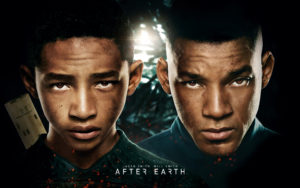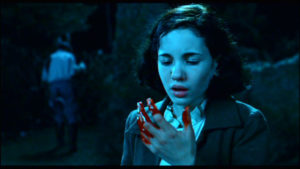How the coming of age and rite of passage fantasy film of twenty-first century cinema has refreshed the depiction of sexual identity and gender roles.
Science fiction and fantasy films can be carriers of contemporary cultural values and aspirations, as such, reflect – and often challenge – the accepted norms of everyday social interaction. They are most popular among young people aged 12-24 years old, who form the largest demographic of cinema-goers (Kochberg, 2012), and who may be expected to ask questions of society. Yet despite often featuring adolescent protagonists, such as in the Hunger Games franchise, few such films project signs of greater diversity in gender role representation, rather adhering to a stereotypical gender representation.
Nevertheless, from the surreal setting of The Wizard of Oz (Fleming, 1939) and the fairy tale world of Disney’s Beauty and the Beast (Trousdale & Wise 1991, Condon 2017), to the futuristic planet-scape of After Earth (Shyamalan, 2013), a weird parallel reality remains an excellent testing ground in order to portray the child in the process of making the painful transition into adulthood.
This essay examines the way gender roles are presented in two relatively recent fantasy/science fiction films: After Earth and Pan’s Labyrinth (Del Toro, 2006). The first film focuses on a young boy’s mission with his military father to save the world from destruction by aliens. The second film depicts a young girl’s epic journey through a war-torn earth and a mysterious underworld, likewise with a mission to save her world, albeit from all too human aggressors. The themes of war and human suffering provide a backdrop to the narrative of growing into adulthood in both films, but there are interesting dimensions to the way gender is handled in each.
One way of examining gender representation is to consider just how complex post-modernism has made the taxonomy of film. Whenever a new film appears, it is often difficult to attribute it to any one style or genre. Villarejo tells us that “genre is an effect of repetition” (2013), and that films use certain codes to orient the viewer towards a whole range of other works that have presented similar stories in the past. The post-modernist theorist Fredric Jameson, on the other hand, stated that ‘stylistic innovation’ is no longer possible, interring that filmmaking looks to the past for inspiration, to reinvent old genres and so lead to hybridity.
After Earth has the semiotics of a science fiction film, with technology, alien creatures, and tension between different world views; however, the syntax is of a rites of passage film in a similar manner to Star Wars (Lucas,1977). As such, After Earth being seen as a science fiction film gives credence to Rick Altman’s theory that genre theory can be preoccupied with semiotics (Etherington–Wright & Doughty 2011).
The father figure in After Earth, played by Hollywood superstar Will Smith, is a classic masculine hero of science fiction genre – a senior military figure with an illustrious past. He embodies the classic heteronormative masculine traits of all military characters: competitive, dominant, strong, requiring almost tacit obedience from his son, and setting high patriarchal standards for his school work and behaviour. The boy’s mother, on the other hand, exhibits stereotypically feminine, nurturing behaviours and is, of course, visually attractive and clad in glamorous evening wear. As such, the parents in After Earth play to the cultural norms of gender as a binary concept. (McNair, 2002).

Figure 1: Poster for After Earth (Shyamalan, 2013)
In this film, the costumes show father and son in matching jump suits, and the facial features of both actors are strikingly similar, which is actually not surprising since they are in real life a Smith family father/son combo. Patriarchy is clearly having a field day in this film, as much on the real-world financial and administrative level as on that of the film’s plot. The boy’s struggle to escape from his father’s oppressive tutelage and find his own identity is achieved through multiple adventures with wild indigenous species. However, there is not much questioning of the macho traditions of the military in this film, nor is there much character progression in either father or son. Junior follows in his father’s footsteps, and will no doubt, in turn, continue this rather rigid and uninspiring method of bringing up his own offspring.
This film shows that American cinema still holds the heteronormative male action hero in high regard, and David Gauntlett suggests this is down to audience expectation, For example, one would expect gender roles to have adapted in the James Bond franchise over the last 50 years, but it has remained relatively unchanged. Both male and female audiences have always reacted better to a more hard-edged Bond, and when Bond had been softened in The Living Daylights (Glen, 1987) , it was immediately reversed in the following film. (Gauntlett, 2008).
In science fiction, Ripley (Sigourney Weaver) in Alien (Scott, 1979) is seen as a ground-breaking character as tough female, which moved away from the male fantasy portrayed in films such as Barbarella (Vadim, 1968), However, Alien can be viewed as simply “role reversal” with Ripley just taking the female equivalent of the clichéd male hero, as little is made of her female characteristics or attributes in regards to justification of her actions. As such, helps to illustrate how the adolescent is portrayed in Hollywood’s science fiction and fantasy, that is, stuck in the gender-segregated world of the mid-twentieth century.
Outside of the Hollywood mainstream, however, the story is not so familiar. The transition from childhood to adulthood is portrayed in fantasy classic Pan’s Labyrinth against the background of the Spanish Civil War. The film harks back to a much older tradition of the allegorical myths of Ancient Greece and Rome, and the moral tales of witches, monsters and talking animals. The film shares some of the same codes as science fiction, such as a fascination with improbable, non-human creatures and exploration of unfamiliar social and political settings. It has a decidedly magical element too, and a strong moral message about the defence of family and territory against any kind of injustice, and against the evils of war in particular.
The supernatural dimension here is provided by the gloomy underworld, into which the young protagonist Ofelia descends. Father figures are menacing, and mostly absent, with even the mother figure in many ways deficient, as Ofelia is left to tackle the problem of human suffering on her own. There is obvious mirroring between the world above and below ground, and a focus on the agency that children have, since in this story it is a young girl who decides her own and her brother’s destiny.
It is possible to view this film with regards to post-feminist culture’s affection for adolescents as an exploration of hybridity (Negra, 2010). Ofelia is both above and below, both protagonist and victim, arguably taking on masculine as well as feminine roles as she faces up to the problem of evil in the world. She must decide to sacrifice her baby brother or suffer herself, and this subverts contemporary Western society’s tendency to depict children as passive creatures guarded by adults, but not allowed to participate in any important matters. The sacrifice of innocence is depicted not through the glorification of a baby, as in the Christian tradition, but through the bravery of a young girl acting out her own moral judgements.

Figure 2: Screenshot from Pan’s Labyrinth (2006 Del Toro)
In this very influential film, it is within the adolescent girl’s power to counter the masculine forces of fascism and war through the sacrificial shedding of her blood. This film illustrates Judith Butler’s theory that gender is not necessarily linked to sex – that is, Ofelia is female, but it is her actions that define her gender (Gill, 2007), and it is this depiction of gender fluidity that evidences a move away from the stereotyping of the past. It has been noted that this director’s films “provoke the audience to question wider political and social questions” (Etherington-Wright and Doughty, 2011). The question of gender is not the main focus of the film, but it is interesting to observe how the ending of the film emphasises the tragedy of female sacrifice: the closing male voiceover at the end narrates the kind and just reign of Ofelia in the underground, which is no doubt intended to contrast sharply with the oppressive reality of the real world. The message seems to be that if women ruled the world, then everybody would live happier and more peaceful lives.
It seems, therefore, that different branches of contemporary cinema are sending different messages in their coming of age films when it comes to gender roles. The post-modern technological future of Hollywood, and of the classic science fiction genre, appears to peddle the classic masculinity as seen in the western of the 60’s and 70’s. Men must teach their sons to go out and subdue the indigenous beings that threaten to stop their all-conquering advance through unexplored worlds.
A new, more magical and much more questioning folkloric perspective is offered by Del Toro’s film. This genre looks inwards and backwards, as well as forwards, seeking to learn from the mistakes of the past, and engage young women in the search for new ways of social interaction that are more effective than the bloody wars of the twentieth century. This new folklore gives voice to a new generation of girls and boys, showing that they need not be closeted by the expectations of the heteronormative society of the 20th Century. They are free to follow their own dreams and are not restricted to the traits of gender assigned at birth. As such, they are better placed to learn from societies past failings and potentially build a safer future for all.
Bibliography.
Condon (2017) Beauty and the Beast [Film] United States: Disney
Del Toro (2006) Pan’s Labyrinth. [Film] Spain/Mexico: Warner Bros.
Etherington-Wright, C. and Doughty, R. (2011) Understanding Film Theory. Basingstoke: Palgrave Macmillan.
Fleming, V. (1939) The Wizard of Oz. [Film] United States: Loew’s Inc.
Gauntlett, D. (2008). Media, gender, and identity [Kindle Edition]. London: Routledge.
Gill, R. (2007). Gender and the Media. 1st ed. Cambridge, UK: Polity Press.
Kochberg, S. (2012) The industrial contexts of film production. In J. Nelmes (Ed.), Introduction to Film Studies. Fifth edition. Abingdon: Oxford, pp. 2-40..
McNair, B. (2002). Striptease culture. London: Routledge.
Negra, D. (2010). What a girl wants?. London: Routledge.
Ross, G. (2012),The Hunger Games. [film]. USA: Lionsgate Films.
Scott, R. (197 9) Alien. [Film]. UK/US: 29th Century Fox.
Shyamalan, M. N. (2013) After Earth. [Film]. United States: Columbia Pictures.
Trousdale & Wise (1991) Beauty and the Beast [Film] United States: Disney
Vadim, R. (1968)Barbarella. [film. France, Italy: Paramount Pictues.
Villarejo, A. (2013) Film Studies: The Basics. Second edition. Abingdon: Routledge.
Watson, P. (2012) Approaches to film genre – taxonomy/genericity/metaphor. In J. Nelmes (Ed.), Introduction to Film Studies. Fifth edition. Abingdon: Oxford, pp. 188-208.
